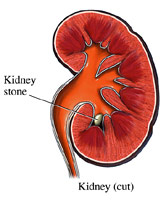Kidney
stones
are
clumps
developed
from
solidified
crystals
in the
kidney
or
urinary
tract.
The
urine
has all
the
ingredients
that
form the
stone,
but all
these
ideally
pass
through
without
our
knowledge.
When
there is
an
imbalance
in any
of these
substances,
the
crystals
cluster
together
into
stones.
The size
of the
stone
can be
as small
as a
grain of
sand to
one as
large as
the size
of a
golf
ball.
The most
commonly
found
kidney
stone in
humans
is
usually
made of
calcium
oxalate.
Other
rare
varieties
of
kidney
stones
include
those
made up
of
cystine,
struvite
(magnesium,
ammonium
and
phosphate),
calcium
phosphate,
uric
acid,
etc.
Kidney
stones
are one
of the
most
painful
of the
urologic
disorders.
Men tend
to be
affected
more
frequently
than
women.
 |
Causes
of
Kidney
stone
formation:
Certain
foods
may
promote
stone
formation
in
people
who are
susceptible.
This
stone
formation
is
enhanced
when
there is
increased
intake
of
calcium,
calcium
oxalate,
uric
acid or
salt in
our
diet,
with an
inadequate
intake
of
fluids.
A
positive
family
history
(genetic
tendency)
also
makes a
person
prone to
kidney
stone
formation.Certain
foods
that
increase
the risk
for
kidney
stone
formation
in
susceptible
individuals
include:
Spinach,
rhubarb,
chocolate,
peanuts,
cocoa,
beet,
coffee,
cola,
nuts,
strawberries,
tomato
juice,
grapefruit
juice,
apple
juice,
soda
(acidic
and
contains
phosphorus),
all
types of
tea, and
berries. |
|
Symptoms
of
Kidney
stones:
Kidney
stones
can
remain
asymptomatic
until
they
obstruct
the flow
of
urine.
When
obstruction
to the
flow of
urine
occurs
at some
point of
time,
the
patient
starts
experiencing
acute
symptoms.
Patient
usually
presents
with the
most
agonizing
pain in
the
lower
back
just
below
the
ribs,
which
often
extends
into the
groin
area
(described
as loin
to
groin
radiation
of
pain).
The
patient
may also
experience
nausea,
vomiting,
blood in
the
urine (haematuria),
restlessness
and
fever
(if
infection
is
present).
Stones
less
than 5
mm in
size
usually
pass out
spontaneously;
however
the
majority
of
stones
greater
than 6
mm
require
some
form of
intervention,
especially
so if
the
stone is
stuck
causing
persistent
obstruction
and/or
infection
of the
urinary
tract.
Suggestion
about
homeopathic
treatment:
When the
stone
size is
small,
homeopathy
is
likely
to help
in the
passage
of stone
as well
as in
relieving
the
agonizing
pain
caused
by the
same. If
the
stone
size is
larger,
or the
stone is
impacted,
or there
are
multiple
stones,
then the
patient
is
better
treated
surgically.
However,
even
after
surgical
removal
of
stones,
homeopathy
still
has a
role to
play in
preventing
its
recurrence
(as the
chance
of
having
recurring
stones
are
about
70-80%). |
|
|
|
Click
here for Case
Studies |
|
|




















